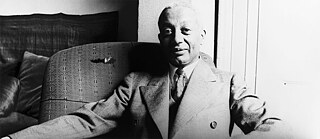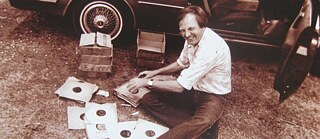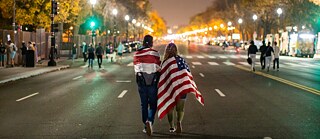Bewegung als Metapher für das Leben der Schwarzen
Black Art, Berlin Stories — Looking for Alain Locke
Dies ist eine Geschichte über Schwarze im Exil und darüber, warum Alain Lockes Vision von einem ‚Neuen Schwarzen‘ in den USA und auch jenseits des Atlantiks weiterhin relevant ist.
Diese Folge anhören: Apple Music | Spotify | Download
Diese Folge stammt von Bilal Qureshi. Bilal ist Radiojournalist und Autor. Er lebt in Washington, D.C. und arbeitet für das National Public Radio (NPR), für „The New York Times“, „The Washington Post“, „Newsweek“ und „Film Quarterly“. 2011 hat Bilal als Stipendiat der Robert Bosch Stiftung für ein Jahr in Berlin und München gelebt. In diesem Podcast unterhält sich Bilal mit Künstler*innen, Historiker*innen und Autor*innen aus Deutschland und den USA. Das Foto zur Folge zeigt Alain Locke und darf mit freundlicher Genehmigung des Moorland-Spingarn Research Center verwendet werden. Außer dieser Episode hat Bilal Qureshi die Folgen „In Friendship“, „Radio Wanderlust“ und „Quietude — In Search of Radio Silence“ produziert. „Quietude“ und „In Friendship“ sind auch auf Deutsch verfügbar. Mit Goethe Aktuell sprach Bilal Qureshi über Podcasting, die Entstehung seiner Folgen für THE BIG PONDER und mehr – das komplette Interview ist hier zu lesen.
Transkript
Bilal Qureshi: My name is Bilal Qureshi and I’m a radio journalist based in Washington DC. I often cover race, identity and American culture. But this is a Berlin Story.[BERLIN STORIES PODCAST OPENING CREDITS: “… THIS IS BERLIN STORIES.”]
Eight years ago, I was selected for a journalism fellowship to live in Berlin. I was ecstatic to leave my cubicle in the newsroom for a whole year and my assignment was to develop a new radio show about international life in Berlin.
[BERLIN STORIES PODCAST OPENING CREDITS: “WELCOME TO THE SUMMER EPISODE OF BERLIN STORIES, A MAGAZINE OF CULTURE AND IDEAS IN BERLIN.”]
We called the show Berlin Stories, after the famous book by Christopher Isherwood set in the city in the 1920s. Personally, I had never lived in a European capital, loitering in parks and museums, interviewing artists. With my rusted bike and newsboy hats, I was the postcard expat cliché.
[STREET MUSIC AND A COFFEE SHOP SCENE: “… ICH HÄTTE GERN EINEN KAFFEE BITTE, SCHWARZ, DANKE.“]
Parked with my laptop at coffee shops in Berlin. But the story of expats, of travelers, of people who go and draw their inspiration from other places has always interested me. What makes you go somewhere else? What impact does it have on the work that you make? But on a personal note, when it came to the community we were covering — American expats — the artists and writers drawing their inspiration from one of Europe’s most creative cities — I often noticed that it was not a very diverse group. The American expats living in Berlin rarely looked like me, were not especially diverse or an especially diverse reflection of what America looks like. One of the first books I ever read about an American expat of color, an African-American artist living in Berlin, was a novel by the writer Darryl Pinckney. It was called Black Deutschland, Black Germany.
Darryl Pinckney: Nothing in Black Deutschland is true. The only thing I share with the narrator is his feeling for Berlin. He is meant to be one of those people who blossoms — or tries to — in this kind of free soil.
Bilal Qureshi: The story of a queer black artist finding his place in Berlin reminded me about how African-American artists have often drawn their inspiration and freedom from beyond American shores. James Baldwin, Nina Simone, and Josephine Baker to name a few. All artists who left the limitations of America for the warmth of other suns.
Darryl Pinckney: Richard Wright often said that there may not be freedom in France, but there’s no Jim Crow in Paris.
David Dibosa: As soon as I cross a border, I am black in a different way.
Bilal Qureshi: The British art historian David Dibosa says while race is a political fact, it is also a social and psychological construction and the way race shifts across borders can be the source of creative freedom, especially for black artists.
David Dibosa: One actually feels it. It’s not just something one has to think about. One feels it. It comes from the airport, or wherever and you start to move around a different city, one is looked at in a different in a way. People come close or don’t in a different way. People address one in a different away. So the ways in which these formations shift and change according to context are really important. They’re subtle and yet they’re palpable in every move that we make.
Bilal Qureshi: Talking to black artists about race and travel made me realize just how profoundly my own time in Berlin years ago helped me come to terms with myself. Berlin gave me breathing room. After I came home to DC from Berlin, I finally came out. I decided to pursue my own writing career. Now as a critic and as a writer, I am always drawn to stories and travelogues by writers of color and of the transformative power of their movement. Last year, I found the best book I’ve ever read on the subject, and a book that really hit close to home.
[DC STREET NOISE]
It’s an extraordinary story of a life and a mind. A story that moves from the segregated neighborhoods of DC to the boulevards of Berlin. The book is called The New Negro, and it’s the biography of an African-American intellectual who once lived in DC named Alain Locke. I recognized the name at because I walk by a house very often in my neighborhood that has a plaque to mark where Alain Locke once lived.
[DC STREET MUSIC AND CHATTER]
[STAND-UP] … and this is what it says. Alain Locke, 1886 to 1954, a leading 20th century intellectual and the nation’s first black Rhodes Scholar, was a central figure in the New Negro, sometimes called the Harlem Renaissance. Locke edited the New Negro, 1925, an anthology of poems, prose and art that helped define this critical cultural movement.
Once upon a time, before the condos and the relentless gentrification here, black intellectuals and artists from DC helped inspire a revolutionary movement in the 1920s. Then called the Negro Renaissance, and now known as the Harlem Renaissance.
E. Ethelbert Miller: A lot of people walk back and forth down these streets and they don’t know who lived and who died here and that’s sad.
Bilal Qureshi: E. Ethelbert Miller is a Washingtonian and a self-professed literary activist.
He has helped the city put historical markers where Duke Ellington once played, where Zora Neale Hurston and Langston Hughes wrote, and where one man in particular helped bring the Harlem Renaissance to life.
[HARLEM JAZZ MUSIC]
To be honest, I didn’t know who Alain Locke was or what exactly he had done. His life had become another silent plaque from DC’s fast fading history. That is, until last year and a landmark new book about his life.
Jeffrey Stewart: This idea of the ‘New Negro’ is someone who can stand in the fire and not be burned.
Bilal Qureshi: Jeffrey Stewart is the author of The New Negro, the Life of Alain Locke. He’s a Professor of African-American History at the University of California at Santa Barbara. Jeffrey Stewart’s biography of Alain Locke won the 2018 Pulitzer Prize and in 2019, the National Book Award. In a renewed age of white supremacy and the politics of hate, The New Negro is the story of why black lives matter and more specifically, why black art matters. My own journey to trace the footsteps and the legacy of Alain Locke begins with his biographer, Jeffrey Stewart.
Jeffrey Stewart: People realized, especially after the presidency of Barack Obama and, you know, what we’ve gone through, that politics is not enough. I think that was something that Locke at sometimes was criticized for. That he wasn’t more of an activist, more of a protest person like Dubois, but I think Locke was saying well okay that’s fine. But there’s something else that you have to do, there’s almost a kind of decolonization of the mind that has to go on in Western culture and also even in people of color to essentially clear out these notions: that we are not beautiful, that we are inept, that we are not as talented as other people because after all, all of that ideology was put together to control us.
Bilal Qureshi: Before the Harlem Renaissance, black Americans had never had the power to tell their story. They had been depicted in popular culture through and by the white gaze as apes, caricatures, and minstrels. Dr. Alain Locke was having none of that. In the 1920s, both DC and New York were buzzing with creative confidence and the music of black poetry and prose, jazz and blues, fur coats and brownstones and just so much swag. Poems like The Black Finger by Angeline Grimke. Read here by New Orleans-based artist Stephanie DeWolfe.
Stephanie DeWolfe: I have just seen a most beautiful thing
Slim and still against a gold, gold sky
A straight black cypress, sensitive, exquisite
A black finger pointing upwards
Why beautiful still finger are you black?
And why are you pointing upwards?
Bilal Qureshi: Pointing upwards and forwards was the central message of The New Negro. The novelist Darryl Pinckney tells me that the key to understanding the Harlem Renaissance lies in the aftermath of the First World War.
Darryl Pinckney: It was an extraordinary period and it was certainly a reaction to the end of the war. The end of the First World War, like the war itself, was a worldwide event in that so much had changed.
Bilal Qureshi: As the war ended in 1919, black soldiers had fought on the frontlines in Europe and experienced the possibilities of a freer life. They were coming home to America transformed by their experiences, as the writer E. Ethelbert Miller explains.
E. Ethelbert Miller: Here were people who might have been in the rural areas of Mississippi or some place in the South, now on the world stage. In cities like Paris, they’re becoming urban people, they’re becoming new people, they’re become actually the ‘Modern Man.’ Because if you go before the early 1900s, you’re almost into people who had felt the lash, you’re dealing with reconstruction, so here in 1900 you begin to see this new idea.
Bilal Qureshi: As Professor Jeffrey Stewart explains, at the beginning of the 20th century, the Great Migration was underway.
Jeffrey Stewart: The idea of leaving the South for the North in the early part of the 20th century occurs, Locke says, not because of social or economic forces, but because of a psychological change and a vision of oneself as possibly being a new kind of person in a new place.
Bilal Qureshi: Alain Locke was already someone who refused to stay in his place. A brilliant student from Philadelphia, he studied philosophy at Harvard and Oxford as the first African-American Rhodes scholar. By the time he arrived in DC to teach at Howard University, he was supremely self-confident.
Jeffrey Stewart: He wanted you to know he was different and also superior.
Bilal Qureshi: Again, biographer Jeffrey Stewart.
Jeffrey Stewart: Locke was probably the most highly Europeanized, or Europhilic let’s say, of the African-American intellectuals of the early 20th century.
Bilal Qureshi: Defying all conventions for where and what a black man could be in the early 1900s, Alain Locke, 4’11” and less than a 100 pounds, would set sail for the Old World whenever he had the chance. He was following in the footsteps of his contemporary and sometimes rival, W.E.B. Dubois, luxuriating in the world of European universities and fashions.
Jeffrey Stewart: Both of them had so completely adopted the German representation of ‘Herr Professor’ in their dress and manner. So if you look at these photographs of Dubois and Locke, I mean they’re always dressed in an extremely formal style, walking with a cane, always having a three-piece suit on. That’s a little bit odd in a place like Washington, even a place that’s fairly formal like Washington.
Bilal Qureshi: Regardless of his cosmopolitan tastes, Alain Locke was still an American Negro, physically confined by segregation even if his mind and imagination refused to settle. Michon Boston is a Washingtonian and a cultural historian. I’ve come to meet her outside Alain Locke’s former home.
Michon Boston: Where we’re standing would have been part of segregated Washington, so I’ve said in my tours, it was a city within a city. There were places black people could go and there were places white people could go. Now here’s the caveat, white people could go to the black establishments and clubs, but black people couldn’t go to the white establishments and clubs.
Jeffrey Stewart: So one hand there’s a vibrant African-American educated community. On the other hand it’s in a colonial relationship with the rest of Washington DC in the area he most cares about, which is the area of art, literature, music and culture. So he has to navigate a world that always has barriers for him.
Bilal Qureshi: As Jeffrey Stewart explains, his movement was confined to this city within a city.
Jeffrey Stewart: But he also is walking through. He’s very small, very highly dressed, almost like a little jewel walking down the street in a city that on the one hand, has a lot of middle class black people, but also has a lot of poor people. Recent migrants from the South who must think, who is this guy, right?
Bilal Qureshi: His arrogance was a product of his intellectual prowess, but it was also a defense mechanism. Alain Locke intentionally lived at an angle from his community. He was a gay man in a time and a place that identity was almost impossible.
Jeffrey Stewart: He called himself at times paralyzingly discreet, but the discretion was necessary to survive in an intensely homophobic world and in a black bourgeois world that knew he was gay, but was going to really react negatively if he did anything that drew their attention publicly to him being gay.
Bilal Qureshi: Jeffrey Stewart says Washington’s black community in particular was built on the foundations of respectable marriages and family life.
Jeffrey Stewart: The sexual tension is always there for him, and what I feel it produces in him is a level of alienation because he will never actually have the support of this community.
Bilal Qureshi: In 1922, we’re talking about somebody, it’s segregated America, resource issues, pre-air travel. Even the physical movement of somebody small and black to Europe on a Grand Tour and I guess when I think of the Grand Tour, I don’t think of a gay black man on that tour so he is uppity in the sense that he ups and leaves and goes places?
Jeffrey Stewart: Exactly. Well it’s interesting you say that because I’ve been talking about this in my class. One of the few benefits, let’s say, that African-Americans get out of Emancipation and the Civil War is mobility. You don’t get the right to vote, you don’t get the right really to earn a lot of money but you do get the right to move, so that right of mobility becomes almost a metaphor for black life. That’s why so much of the blues songs are about trains and riding in trains and walking and riding, the wandering blues, right? So that mobility is something cherished, it’s not something taken for granted. So for Locke then the mobility to go to Europe and continually so is a right, it’s sort of like his Declaration of Independence. He knows it’s not set up for him, but at the same time he’ll take advantage of it.
[BERLIN STREET MUSIC]
Bilal Qureshi: In 1922, Alain Locke’s mother died. She was his sole family, and he was devastated. He gathered himself and set sail for the city he loved most: Berlin, Germany. So I followed Alain Locke back to Berlin. Berlin, the romantic capital of Café Society, academics, and endless reinvention.
Stuart Braun: As I started to reach out to that era, there were so many interesting people who no one had ever heard of.
Bilal Qureshi: I’ve come to a café in Berlin to meet the journalist and writer Stuart Braun. He’s written a book called the City of Exiles that traces the generations of outsiders who have called Berlin home.
Stuart Braun: We’re sitting on Paul-Lincke-Ufer on the canal here in Kreuzberg, and Paul Lincke was a composer back in the late 19th century. He wrote a famous song called the Berliner Luft, and it was all about the allure of Berlin’s air, of course not being oxygen, but being this kind of intangible essence of Berlin that once you breathe it, it draws people in. Once you get a sniff of the ‘Berliner Luft’ [LAUGHS] you, it’s intoxicating.
Bilal Qureshi: Germany in the 1920s was at the center of an intoxicating experiment. Shattered and destroyed by the loss of the First World War, the country emerging from the ashes of 1919 was a fragile and hopeful democracy, a society defined by experimentation.
Jeffrey Stewart: Berlin in the Weimar Period is a place with spectacular promise.
Claudia von der Heyde: It was the spirit of the Enlightenment, really. That’s what they tried to put into the new constitution for this new democracy, this new republic.
Bilal Qureshi: Claudia von der Heyde is a guide with the Weimar Klassik Foundation in the city of Weimar. In the plaza outside the Weimar National Theater, students are skateboarding around the statue of Goethe and Schiller, the writers who define German Romanticism.
[STUDENTS CHATTING AND LAUGHING]
It’s the monument outside the place where politicians gathered 100 years ago to draft the constitution of a new republic.
Claudia von der Heyde: They had to pass this monument every day when they went to work. And it’s kind of natural that they tried to incorporate some of the spirit of this epoch into their work and into the constitution and they chose the name Weimar Constitution for it.
Bilal Qureshi: As America entered its Jazz Age — the roaring 20s as it were — Berlin became ‘Babylon Berlin,’ the throbbing industrial and cultural heart of the Weimar years, the Golden 20s. And this was the extraordinary moment in time into which Alain Locke arrived from Washington.
Uli Hanisch: Imagine yourself in a surrounding where everything around you kind of changes on a daily basis in a way you’ve never seen before and nobody was able to tell you about it before, because it didn’t exist before.
Bilal Qureshi: Uli Hanisch is one of the artists behind the award-winning German television series Babylon Berlin. He’s a production designer and has led the team that meticulously recreates Weimar Berlin for one of the most expensive TV shows ever made in Germany.
Uli Hanisch: Jazz music obviously has been invented entirely somewhere else, but if you listen to jazz, and again you have the same motifs, you have the speed, you have the improvisation, the innovation to turn everything upside down, try something else, exactly in the schemes of what was happening here.
Bilal Qureshi: Again Uli Hanisch and the writer Stuart Braun on the spirit of 1920s Berlin.
Stuart Braun: It went from 400,000 people and it went up to 4 million by 1930 and that was fueled by this massive influx of people.
Uli Hanisch: It was like growing, you know, like a virus.
Stuart Braun: It was so vibrant, there were so many gigs, you know, there was a lot of money around.
Uli Hanisch: People go to work very early, would come home, re-dress, go out, dance all night, go back to work, meet people, go from one bar to the other, then again to a museum or whatever or an exhibition and then there’s another dance performance and another thing and everything, all the time, something is up. I think people must have been really crazy.
Stuart Braun: And you had all these transgressive clubs and this whole underground worlds, right here in Kreuzberg you had Auden and Isherwood and those guys going to these bars where they you know, they felt they could be themselves.
Jeffrey Stewart: Locke seldom has that experience in the United States.
Bilal Qureshi: Alain Locke’s biographer Jeffrey Stewart is talking specifically about gay sex and the life that was denied to him at home in America. In the summer of 1922, Locke dove into Berlin’s music scene, its galleries, the modernist theater and the literature. He lingered in cafés, wrote criticism and indulged in the pleasures of the flesh, as well, as Jeffrey Stewart explains:
Jeffrey Stewart: Berlin is experimental in a way in which Washington never is. Washington is always going to follow the tried and true. Berlin though adds that extra element that your identity is being uplifted, that you’re being fueled by the possibilities of a new civilization, a new culture coming into existence that is racially tolerant, that is sexually tolerant, and that essentially is an aesthetic world.
Bilal Qureshi: At the forefront of defining that aesthetic world was the emergence of Weimar Germany’s legendary Bauhaus School for art and design.
Claudia Perren: My name is Claudia Perren, and we’re meeting at the Bauhaus in Dessau. So this is actually the original school building, built in 1925. One hundred years ago, Germany was, you know, first democracy, first time a woman could vote and was also a first time a woman could actually study. So in that time a school was set up that really wanted to contribute to a totally new society, to really go forward, to choose always a progressive way and not looking back.
Bilal Qureshi: The term modernism and modern is a term that we now use about this period but I’m wondering in this school and when the masters were here and the administration, what language would they have been using? Would they have been words like modern, progressive, I mean, radical, like these are the things we now use to describe what they were doing, but I’m curious what the language and the vocabulary of their ethos was here?
Claudia Perren: Yeah that’s actually a good question. They used a lot ‘new.’ It was about new design and new school and even new people and new time. So everything needed to be new.
Bilal Qureshi: So the term was new. New was really the word?
Claudia Perren: New was really the word. Yeah.
Bilal Qureshi: Among the clean lines and minimalist white walls of the new Bauhaus Museum in Weimar, my guide Claudia von der Heyde tells me the Bauhaus vision for design was not based on an aesthetic sensibility, but it was about a philosophical question.
So we’re looking out here at this idea of the New Man. Tell me a little about this?
Claudia von der Heyde: Well the idea of the New Man has been around since about 1900 because people felt that life had changed so much and that the challenges of modern life were to be met, and they were asking themselves if they didn’t need New Man to actually do that and achieve that and there were different approaches, so have a little gallery of different ideas…
Bilal Qureshi: In the 1920s Germany was in the midst of an intellectual awakening. It was precisely that spirit that the Nazis sought to crush when they shut down the Bauhaus and burned the Weimar Republic to the ground. But in those exciting first years, Alain Locke had a front-row seat to the making of a renaissance. He realized that for there to be a ‘New Man,’ there had to be the death of the ‘Old.’ For there to be a ‘New Negro,’ there had to be the end of the ‘Old Negro.’ Jeffrey Stewart tells me that Locke’s letters home to Washington from Germany reveal that while he was enjoying his exile, he knew he had to come back to the United States.
Jeffrey Stewart: I’m over there, it’s great, I’m in the summer, I’m living this lifestyle –and yes, it is true he has a job here and he has to return for that reason. But also the work to be done is here, and there’s something he gets out of doing that work that simply being in exile in Europe would never really satisfy.
Bilal Qureshi: So Alain Locke returned to Washington in the fall of 1922.
Michon Boston: Well one thing about traveling slow, it gives you a lot of time to think and process, and it also gives you a sense of distance of where you’re coming from and where you’re going.
Bilal Qureshi: Again cultural historian Michon Boston.
Michon Boston: Having no airplane travel, at least transatlantic for regular passengers at the time, it gave Alain Locke a lot of time to process what he wanted to do and what he wanted to accomplish.
Bilal Qureshi: And what he wanted to accomplish was hugely ambitious. He wanted to build a black artistic movement in the spirit of what he’d seen in Germany — freed from the tentacles of the white gaze — undeniable in its exuberance and self-confidence.
Michon Boston: One thing that has always inspired me is that he did build the “Negro Arts Movement,” as it was called here in Washington DC
Bilal Qureshi: Locke traveled back and forth between Harlem and DC, assembling salons and seducing new writers with his charms. Zora Neale Hurston, Langston Hughes, among others.
E. Ethelbert Miller: So you’ve got Jean Toomer here, you got Alain Locke here, you got Georgia Douglas Johnson here, you got Langston here at that time, so that’s when you begin to say, this is a New Negro Movement.
Bilal Qureshi: The writer E. Ethelbert Miller says Locke was an editor on a mission.
E. Ethelbert Miller: When you’re an editor and seeing the big picture and making comparisons and maybe interacting with people’s work. That’s a different thing, you know, you might say, okay, Bilal, write more of this, claim that, what are you trying to say here, give me more. No different than your Duke Ellington telling somebody, stop here, let’s play that again, right here again, because I need you to get that deeper sound out of your horn.
Bilal Qureshi: Locke became the curator, the convener, and the guiding force of the Harlem Renaissance. The result were pieces like this poem by Georgia Douglas Johnson, read here by the singer Priska Neely.
Priska Neelly: Ho! my brother,
Pass me not by so scornfully
I’m doing this living of being black,
Perhaps I bear your own life-pack,
And heavy, heavy is the load
That bends my body to the road.
But I have kept a smile for fate,
I neither cry, nor cringe, nor hate,
Intrepidly, I strive to bear
This handicap. The planets wear
The Maker’s imprint, and with mine
I swing into their rhythmic line;
I ask — only for destiny,
Mine, not thine.
Bilal Qureshi: What began for Locke as a special issue of Survey Graphic Magazine grew into a full book, edited and composed by Professor Alain Locke. It was called The New Negro.
Jeffrey Stewart: Having your own agenda and believe you can realize it is key to The New Negro.
Bilal Qureshi: As Jeffrey Stewart explains, Locke wanted black artists to believe in their capacity to be more than what America had told them they could and should be.
Jeffrey Stewart: Because I believe that those people have the capacity to become dreamers and creators and imagine a new and better America out of that culture than exists already today.
Bilal Qureshi: Jeffrey Stewart tells me that Germany remained a tangible influence on Locke’s work in The New Negro. He commissioned artist Winold Reiss to illustrate The New Negro. The artist created extraordinary portraits of black men and women, turning away from the caricatures that they had been seen as and transforming these black men and women into stylish, modern icons of beauty.
Jeffrey Stewart: When you look at those pictures, there’s a feeling that comes through of the ‘New Negro’ — self-confidence, pride, assertiveness, lack of deference to white supremacy, all of those kinds of attitudes he was able to capture and express.
Bilal Qureshi: And always the spirit of Weimar Germany was on Locke’s mind, the transatlantic birth and the quest for the ‘New Man.’
Jeffrey Stewart: Locke is trying to imagine Harlem as Berlin when he writes some of his essays about Harlem. He wants it to be a place where there is sexual tolerance, where there is creative experimentation.
Bilal Qureshi: Sadly, the Great Depression wiped out the material circumstances that made the Harlem Renaissance possible. On the other side of the Atlantic, the Nazis destroyed Weimar Germany once and for all. Locke knew he could never return. World War II and the Cold War followed. Alain Locke died in 1954, but his message of black beauty lived on in the civil rights movement and in the Black Arts Movements of the 1960s and 1970. The term ‘negro’ may be out of fashion, but the spirit of the movement lives on.
Jeffrey Stewart: This issue of beauty I think remains. Even today, it’s a struggle going on. We’re still really trying to get out from under essentially colonial notions of who is important, and what is beautiful.
Bilal Qureshi: Jeffrey Stewart says Alain Locke would have loved what’s happening in 2019. To see his vision bear fruit at the scale it does now.
Jeffrey Stewart: I think we’re really living in Alain Locke’s moment.
Bilal Qureshi: In the cinema of filmmakers like Barry Jenkins and Ava DuVernay, in the writings of Ta Nahesi Coates and Kendrick Lamar. Jeffrey Stewart says one lesson to be drawn from Locke’s life is not to feel confined by society’s limitations. Alain Locke didn’t stay in his lane or in his own country. He never sought the comfort of safe spaces. As a gay black man in 1920s America, there were very few places that were safe for him. Instead, he proudly created his place in other people’s spaces.
Jeffrey Stewart: Locke had his sanctuaries, but at the end of the day he felt he could go out and engage people who were different from him and colonize them to his agenda and his program rather than feeling that if I engage with these people, somehow I’ll lose my way and myself.
Bilal Qureshi: Claudia Perren, who you heard from earlier, is the director of the Bauhaus foundation in Dessau. She says that as Germany celebrates the 100th anniversary of the Bauhaus, that spirit of innovation and new ideas – that the same question is being asked again. What is the way to take things forward?
Claudia Perren: You have to see the conditions of our time and to find answers. And what helps with the Bauhaus, I think, is that you try to encourage yourself to go forward, you know to not try to look back so much and think ‘oh you know the holy times, that was wonderful in the 20s’ but say no, it’s a different time, we have to go forward, new conditions, and it’s really up to us what we do with it.
Bilal Qureshi: In 1925, Alain Locke dedicated The New Negro to ‘the younger generation.’ In his own epilogue to his biography of Alain Locke, Jeffrey Stewart dedicates his book to a new generation and he writes this: ‘A ‘New Negro’ is in all of us — not just African-Americans — but every American who embraces this capacity for reinvention through African forms, because those forms are in them too, waiting, like the rest of us, to be released to soar.’
Jeffrey Stewart: … and I think that kind of confidence is really the essence of The New Negro as I would like to see it realized today, that confidence that we have a great tradition, we have a great art, we have a great history. We don’t really need to be intimidated. I think there’s a level of intimidation that’s often part of the work of racism, and I think part of The New Negro is ‘I will not be intimidated’.
[BERLIN STREET MUSIC]
Bilal Qureshi: Jeffrey Stewart is the Pulitzer-Prize winning author of the book The New Negro — The Life of Alain Locke. From Washington DC, the city where ‘New Negro Renaissance’ was born and where Alain Locke once lived, I’m Bilal Qureshi.







